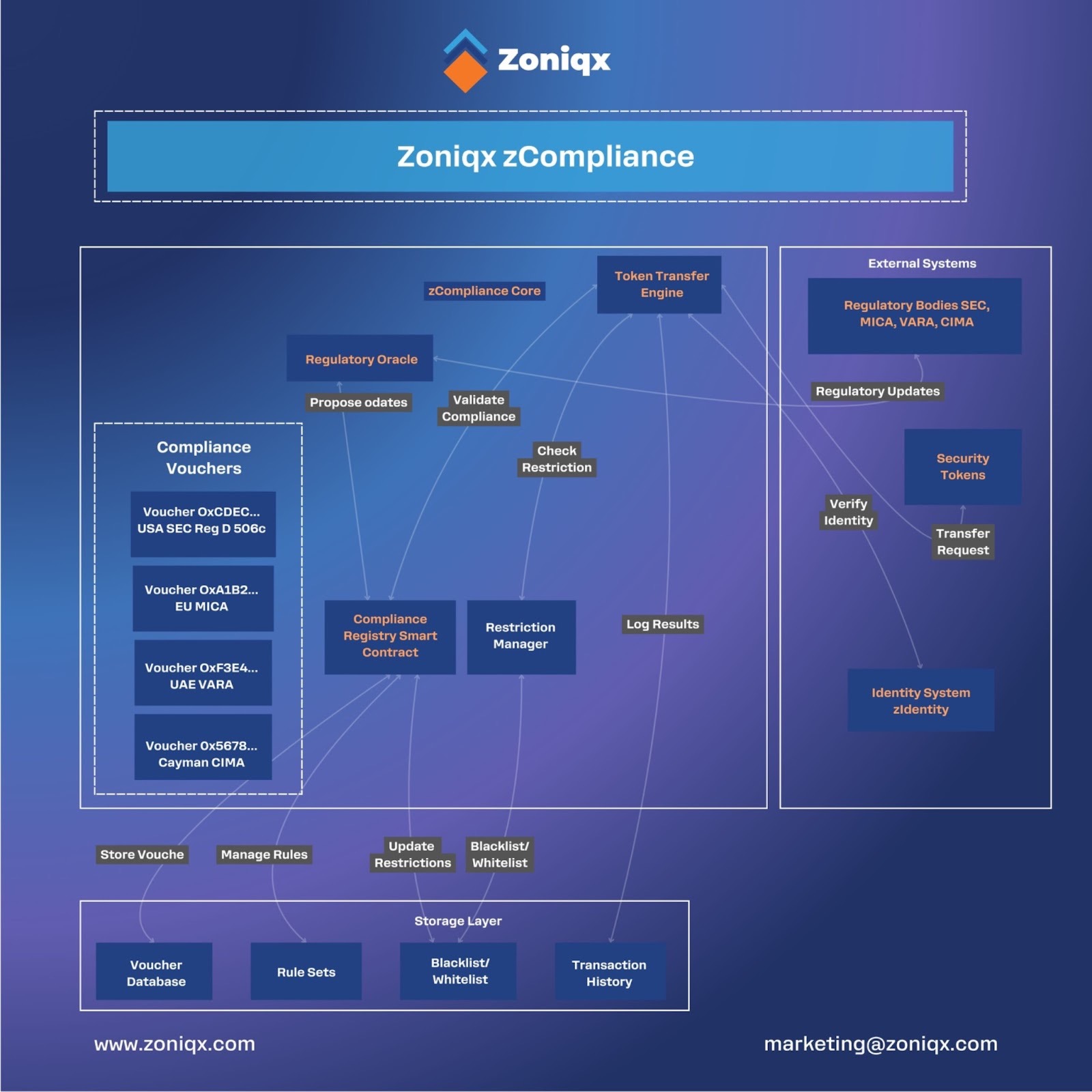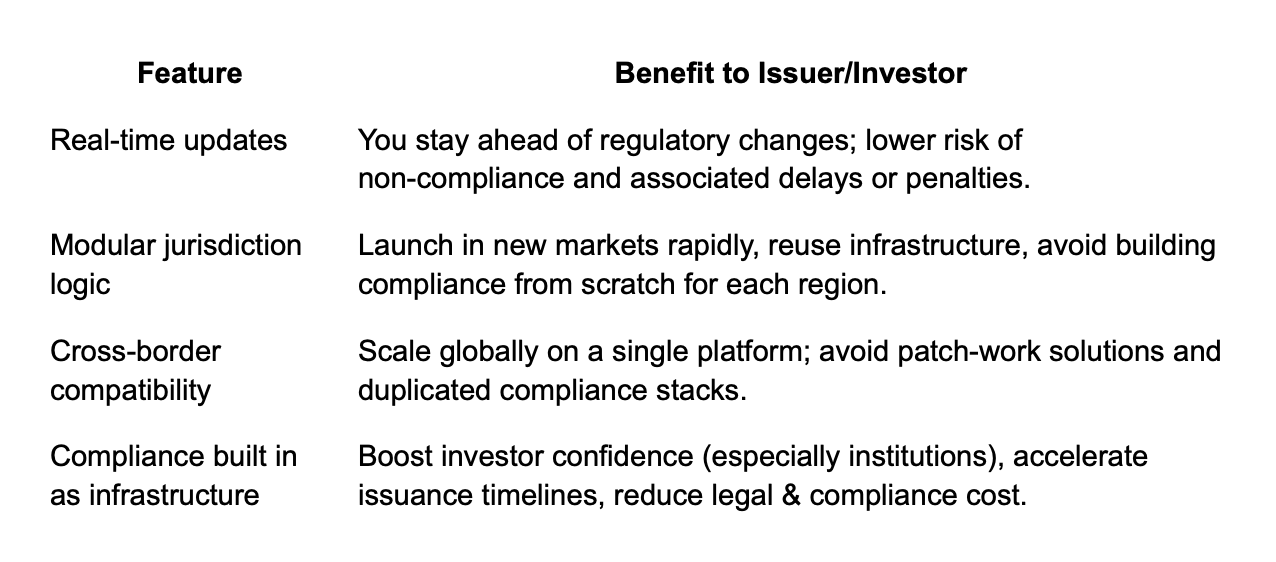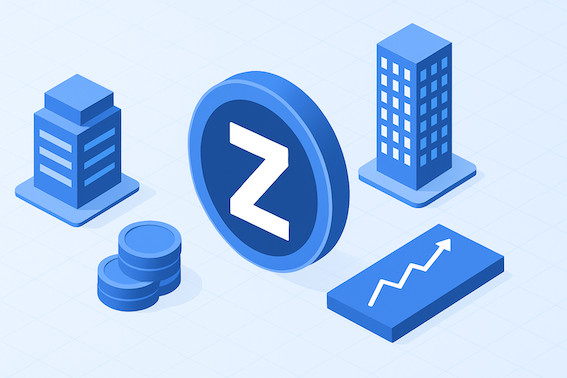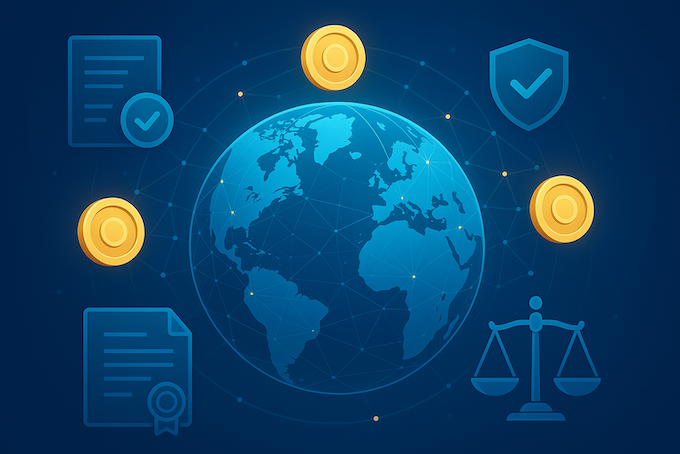Regulatory Fragmentation Is the Real Bottleneck to RWA Tokenization Here’s How zCompliance Breaks Through It
The token-economy buzz around real-world assets (RWAs) has reached a fever pitch. Across the industry, asset-owners, issuers and digital-asset platforms are racing to convert real-estate, private credit, infrastructure, and other “real-world” assets into programmable, tradable tokens. Indeed, the token-market for RWAs is surging, yet one of the loudest obstacles remains regulation. As recent commentary puts it: “the real challenge is not technical: it is regulatory.”
Many tokenization projects stall or fail not because the blockchain layer is immature, but because issuers face a patchwork of overlapping, shifting, and jurisdiction-specific compliance regimes.
In short: you can build an elegant smart contract and a beautiful token interface, but if you can’t satisfy a regulator (or dozens of them) across borders, the issuance remains stuck, investors remain hesitant, and global scale remains elusive.
That’s where zCompliance from Zoniqx comes in: a dynamic, proactive compliance engine built specifically for global RWA tokenization. Let’s dive into how it works, why it matters, and how it adds tangible value to token issuers.
The Problem: Compliance ≠ After-thought
Why regulatory complexity is slowing RWA tokenization
- Regulatory ambiguity + fragmentation
Many jurisdictions still lack clear legal frameworks for tokenized real-world assets: Is the token a security? A digitised representation of property? A hybrid? The lack of clarity drives legal risk, slows due-diligence, and forces tokenization projects to reinvent compliance for each region. - Jurisdiction-specific logic and cross-border complexity
Token issuers often aim for global distribution but must comply with local securities laws, AML/KYC regimes, disclosure norms, and asset-registration rules in each jurisdiction. One token, many markets, but hundreds of rule-sets. - Reactive vs. proactive compliance
Traditional compliance tends to be “we’ll fix it if regulators find issues” rather than built-in. As rules shift, issuers struggle to adapt quickly, creating delays or entanglements. - Investor confidence & scalability
Without robust compliance embedded, institutional investors remain cautious. Tokenization’s promise of liquidity and global access remains muted. - Time to market & cost overhead
A platform that has to rebuild or audit for every region adds significant cost and delay, the two things tokenization was supposed to reduce.
In summary: the technology is available, the business case is vivid, but regulatory & compliance friction remains a major drag on adoption.
zCompliance: The Solution You’ve Been Waiting For
Enter zCompliance, Zoniqx’s global regulatory compliance/dynamic compliance engine.
At its core, zCompliance flips compliance from reactive to proactive, automated and modular:
- Real-time regulatory updates: The engine automatically adapts as regulatory requirements change, meaning issuers no longer wait for manual rule-updates or patches when a law shifts.
- Jurisdiction-specific logic: The platform is built on a modular architecture. Plug-in rule-sets for different jurisdictions mean that token creators can select geography-specific compliance modules without rebuilding the whole system.
- Cross-border compatibility: Because the logic is modular and globally orientated, token issuers can deploy to multiple jurisdictions with a unified compliance backbone rather than “one market at a time.”
- Global market access: zCompliance enables institutions to go global without wrestling with compliance in each new market, enabling faster go-to-market, reduced legal overhead and scalable operations without compromising regulatory fidelity.

In essence: zCompliance is the compliance infrastructure layer that the RWA tokenization market has been missing.
The Value Proposition: What zCompliance Delivers
Feature-Benefit mapping

Business outcomes
- Faster time to market: Token issuers aren’t blocked by local compliance build; they deploy and scale faster.
- Reduced legal/advisory overhead: With compliance logic embedded, fewer bespoke reviews, fewer delays, fewer re-work cycles.
- Scalability and repeatability: Once compliance infrastructure exists, new issuances in new jurisdictions become incremental rather than ground-up.
- Investor trust and institutional readiness: A platform with embedded, multilayered compliance resonates better with institutional capital, raising odds of large scale uptake.
- Reduced regulatory risk: With proactive rule-adaptation and jurisdiction modules, you minimise the chance of surprises, penalties or enforcement actions.
In short: zCompliance addresses one of the most persistent frictions in RWA tokenization: compliance, by building it into the workflow rather than as an add-on.
Why zCompliance Matters for Blockchains
For a blockchain to thrive, it’s not enough to be fast, secure, or scalable. The real barrier to institutional adoption and ecosystem growth is compliance. Without it, issuers, transfer agents, and platforms struggle to launch compliant tokens, limiting activity on the chain.
zCompliance changes that. By embedding compliance directly on-chain, any authorized Transfer Agent, Asset Issuer, or Platform can define customized rulesets for token transfers. Any token standard on the chain can now adopt a compliance layer, meaning issuers don’t need to compromise on functionality or risk regulatory breaches.
For the blockchain itself, this creates a more vibrant, trusted ecosystem: issuers can launch compliant tokens faster, platforms can support more products, and institutional participants gain confidence to engage. With zCompliance, compliance becomes a growth enabler, not a bottleneck, letting blockchains scale securely across jurisdictions.
Conclusion
The real race in RWA tokenization isn’t about who has the best blockchain, it’s about who can scale without tripping over regulation. Every serious issuer wants global reach, but the moment they move beyond a single jurisdiction, compliance becomes a growth ceiling.
zCompliance flips that reality.
Instead of treating regulation as a hurdle that slows expansion, it turns compliance into a built-in, automated layer that adapts as fast as markets evolve. No re-engineering for every country. No legal restart every time rules shift. No fragmentation between markets.
In a space where most platforms are still reactive, zCompliance is built for the world we’re moving into: multi-jurisdictional, institutional, and regulation-first.
Tokenization will only scale when compliance scales with it. That is the gap zCompliance is designed to close.
FAQs
Q1: How does zCompliance stay updated with changing global laws?
A: The engine includes an automated regulatory-monitoring layer that tracks regulatory changes across jurisdictions. When a rule shifts (for example investor accreditation thresholds, transfer restrictions, reporting requirements), the platform flags the change and updates the relevant compliance module in near real-time. This means issuers don’t need to rebuild or audit every region manually.
Q2: Can zCompliance support both crypto-native token issuers and traditional financial institutions?
Yes, the design is institution-grade, built to support traditional financial institutions (which demand strong governance, auditability, compliance) while also serving the token issuance use case in blockchain platforms. The modular architecture means the same compliance backbone can service both “crypto-native” and “trad-finance” issuances.
Q3: Does zCompliance only work with Zoniqx’s proprietary token protocol or can it integrate with external token standards?
zCompliance is built as a modular compliance engine, it can operate with Zoniqx’s token issuance platform and standards, but is also designed to integrate with other token standards or issuance workflows. The key is the compliance layer: whichever token standard you use, the compliance logic plugs in.
Q4: How quickly can an issuer go live using zCompliance?
Because the compliance modules are pre-built and the architecture is plug-in, an issuer can target deployment in new jurisdictions far faster than building compliance rule-sets from scratch. Early adopters are reporting significantly reduced legal/operational lag times. (Specific timelines depend on token asset class, jurisdiction, and issuance complexity.)
Q5: Can regulated institutions customise rule-sets in zCompliance?
Yes, while the core modules deliver standard compliance logic, token issuers and institutions can configure or add custom rule-sets, jurisdiction-specific tweaks, investor-eligibility criteria, reporting/monitoring workflows, and whitelisting/blacklisting logic as required by their risk profile.
Q6: Is zCompliance legally recognised across regulated markets?
zCompliance is built to meet regulatory expectations and support issuers in regulated markets, but as with any digital assets infrastructure, legal recognition still depends on local laws and regulatory approval. zCompliance is designed to meet the highest institutional compliance standards to maximise acceptance and minimise legal risk.
Q7: What’s the incremental cost of using zCompliance compared to building your compliance stack internally?
While cost varies, the value model is clear: building and maintaining your own global compliance logic per jurisdiction is expensive and slow, and likely to require ongoing legal rebuilds as rules change. zCompliance provides a packaged, recurring-use infrastructure layer, which reduces incremental cost and maintenance overhead for each new issuance or new market.
Final Thoughts
If you’re in the business of tokenizing real-world assets, whether real estate, infrastructure, private credit or alternative assets, the lesson is clear: technology is no longer the core barrier. Compliance is. The difference between a tokenization project that sits and one that scales globally comes down to whether regulatory logic is embedded in the platform or built around the project.
zCompliance from Zoniqx is a paradigm-shift: compliance becomes infrastructure, not after-thought. You get real-time regulatory updates, plug-in jurisdiction logic, cross-border compatibility and institutional readiness, all built to help you scale globally, faster, and with lower legal burden.
If your ambition is global issuance, institutional investors and repeatable token programmes, then the compliance engine you choose matters. zCompliance gives you the head-start.
Ready to issue fully-compliant RWAs globally, without reinventing compliance for each jurisdiction? Visit www.zoniqx.com and discover how zCompliance can power your roadmap.
About Zoniqx
Zoniqx (pronounced "Zoh-nicks") is a global fintech leader headquartered in Silicon Valley, specializing in converting real-world assets into security tokens. Through its suite of innovations including zProtocol (DyCIST/ ERC-7518), zCompliance, zConnect, zPayRails, and zIdentity, Zoniqx is powering the future of finance, enabling global liquidity, compliance automation, and Web3 integration.
It offers an interoperable, compliant infrastructure for the RWA tokenization market, enabling global liquidity and DeFi integration through its end-to-end ecosystem of SDKs and APIs. Zoniqx pioneers on-chain, fully automated RWA deployment on public, private, and hybrid chains. For more information, visit www.zoniqx.com.
To explore how Zoniqx can assist your organization in unlocking the potential of tokenized assets or to discuss potential partnerships and collaborations, visit www.zoniqx.com/contact.
Disclaimer: This article is for informational purposes only and does not constitute legal, financial, or regulatory advice. References to SEC are based on public statements and do not imply endorsement or legal interpretation. Readers are encouraged to consult with legal or regulatory professionals before engaging in asset tokenization. Zoniqx operates in full compliance with applicable laws and supports regulatory clarity in the tokenization ecosystem.



